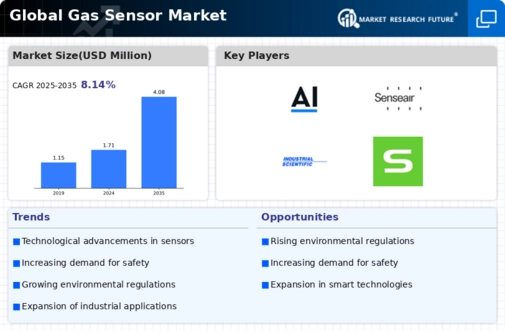Top Industry Leaders in the Gas Sensors Market

The Competitive Landscape of the Gas Sensors Market
The gas sensors market, encompassing devices detecting and analyzing the presence and concentration of gaseous compounds, thrives amidst growing concerns about air quality, safety, and industrial automation. This dynamic landscape sees established players jostling with nimble startups, all vying for a slice of the market fueled by diverse applications across various industries.
Some of the Gas Sensor companies listed below:
- City Technology Ltd
- Dynament
- AlphaSense
- Amphenol Corporation
- Bosch Sensortec GMBH
- AMS
- SenseAir
- NEW COSMOS ELECTRIC CO. LTD.
- Industrial Scientific
- Sensirion
Strategies Adopted by Leaders
- Portfolio Diversification: Offering a comprehensive range of gas sensors catering to different gas types (toxic, flammable, environmental), detection methods (electrochemical, catalytic, infrared), and application areas (industrial, environmental monitoring, personal safety) expands market reach and attracts diverse customers.
- Technological Innovation and Feature Integration: Continuous investment in R&D focuses on advancements like higher sensitivity, faster response times, improved selectivity (distinguishing specific gases), and integration with wireless communication and internet of things (IoT) platforms, ensuring cutting-edge offerings.
- Focus on Miniaturization and Low Power Consumption: Developing compact and energy-efficient gas sensors caters to portable devices, wearable technologies, and battery-powered applications in remote locations.
- Strategic Partnerships and Collaborations: Partnering with equipment manufacturers, system integrators, and technology providers accelerates technology adoption, expands distribution channels, and fosters joint development projects.
- Focus on Regulatory Compliance and Certifications: Ensuring adherence to industry standards and safety regulations for specific applications builds trust and opens doors to government contracts and critical infrastructure projects.
Factors for Market Share Analysis:
- Sensor Performance and Reliability: Delivering high sensitivity, accurate detection, fast response times, and dependable operation under varying conditions sets players apart and caters to diverse application demands.
- Sensor Type and Selectivity: Offering a variety of sensor types with high selectivity for specific target gases is crucial for applications like environmental monitoring, leak detection, and industrial process control.
- Cost-Effectiveness and Price Point: Striking a balance between performance, features, and competitive pricing is crucial for attracting budget-conscious customers and expanding market penetration in cost-sensitive industries.
- Size, Power Consumption, and Integration Ease: Compact size, low power consumption, and seamless integration with existing systems are critical for applications like wearable devices, portable gas monitors, and battery-powered IoT sensors.
- Brand Reputation and Customer Support: A trusted brand image built on reliable sensors, robust technical support, and proven performance in industry-specific applications fosters customer loyalty and repeat purchases.
New and Emerging Companies:
- Niche Market Focus: Targeting specific areas like personal air quality monitors, smart home gas leak detection systems, or agricultural sensors for monitoring methane emissions opens up new market opportunities.
- Low-Cost Sensor Solutions: Utilizing alternative materials and innovative manufacturing processes allows them to offer cost-effective gas sensors for less demanding applications or emerging markets.
- Direct-to-Consumer Online Sales: Leveraging online platforms and social media marketing enables them to bypass traditional distribution channels and reach customers directly, often at competitive prices.
- Focus on Emerging Technologies: Integrating technologies like nanomaterials for enhanced sensitivity, artificial intelligence (AI) for advanced data analysis and pattern recognition, or miniaturized optical sensors positions them at the forefront of future market trends.
Industry Developments:
June 2023- British sensor maker Alphasense has introduced a new, more compact sensor type for use in mobile devices, with applications including air quality monitoring and safety gas detection. The H-Series sensor is available for 9 target gases and is smaller, thinner, and lighter than the 1-Series sensors of competing vendors. Alphasense's H-series provides original equipment manufacturers with more sensor options and design freedom for their instruments. H-Series is more versatile than merely a compliance monitor because to its nine sensor variations, which cover both common and unusual gases. OEMs now have the option of including hydrogen immunity as standard in compliance devices thanks to the H2cross-sensitivity CO sensor and the dual CO/H2S sensor, which together allow for the integration of a fifth sensor in a four-gas enclosure.
September 2023- NASA took another step toward launching its greenhouse gas detector. Carbon Mapper, a non-profit, will be able to locate and quantify sources of methane and carbon dioxide from orbit thanks to this technology. This month, components for a cutting-edge imaging spectrometer, which will detect methane and carbon dioxide from orbit, arrived in a clean room at Planet Labs PBC (Planet) in the United States, bringing launch day that much closer. Targeted data on "super-emitters" (the tiny number of sources responsible for a disproportionate share of global methane and carbon dioxide emissions) will be made available via the Carbon Mapper imaging spectrometer. The spectrometer monitors the light reflected from Earth's surface and absorbed by gases in the atmosphere across a wide range of wavelengths. Invisible to the naked eye, these infrared fingerprints can help identify and quantify significant greenhouse gas emissions, which can then be used to expedite future mitigation measures.
